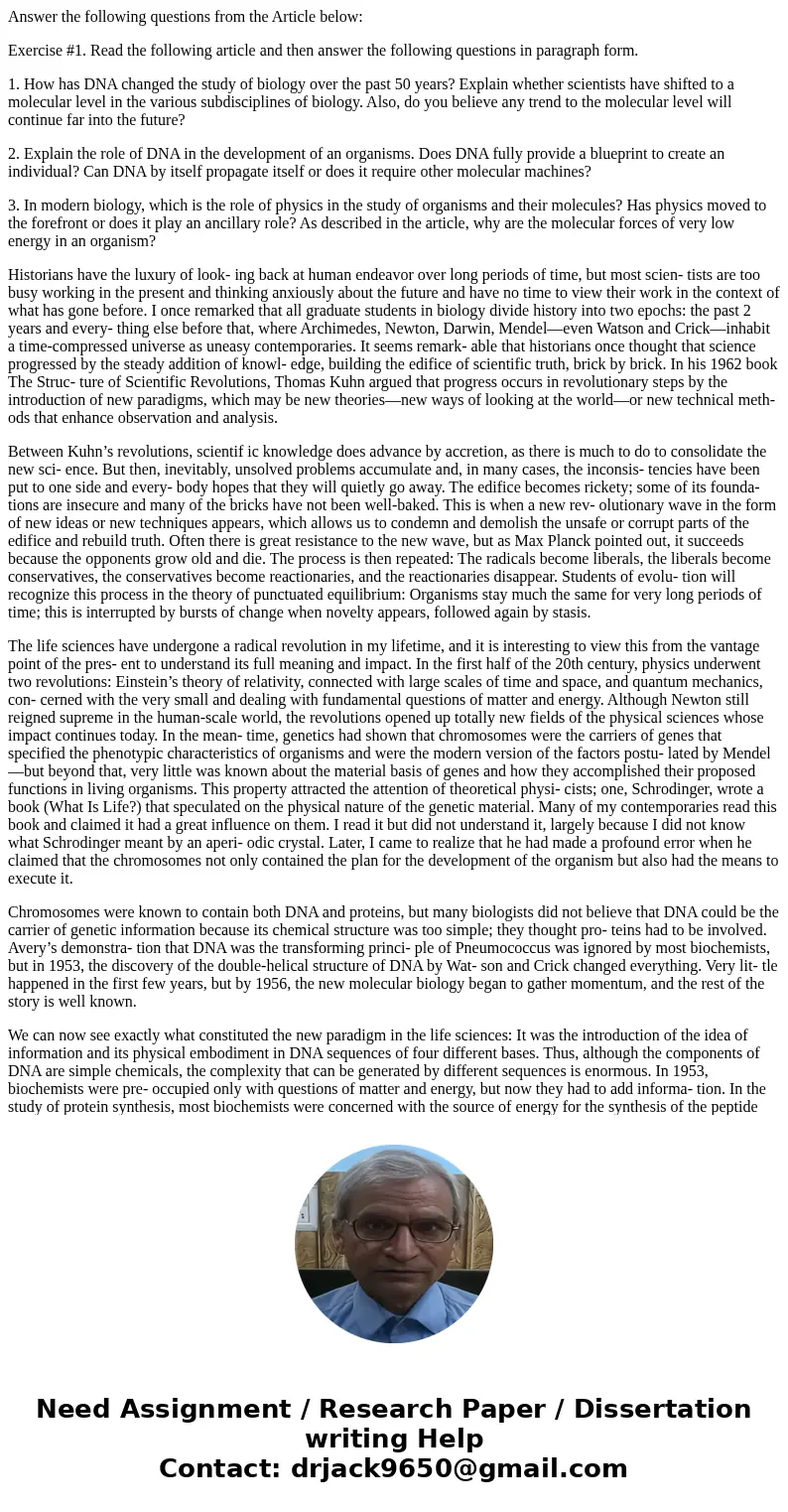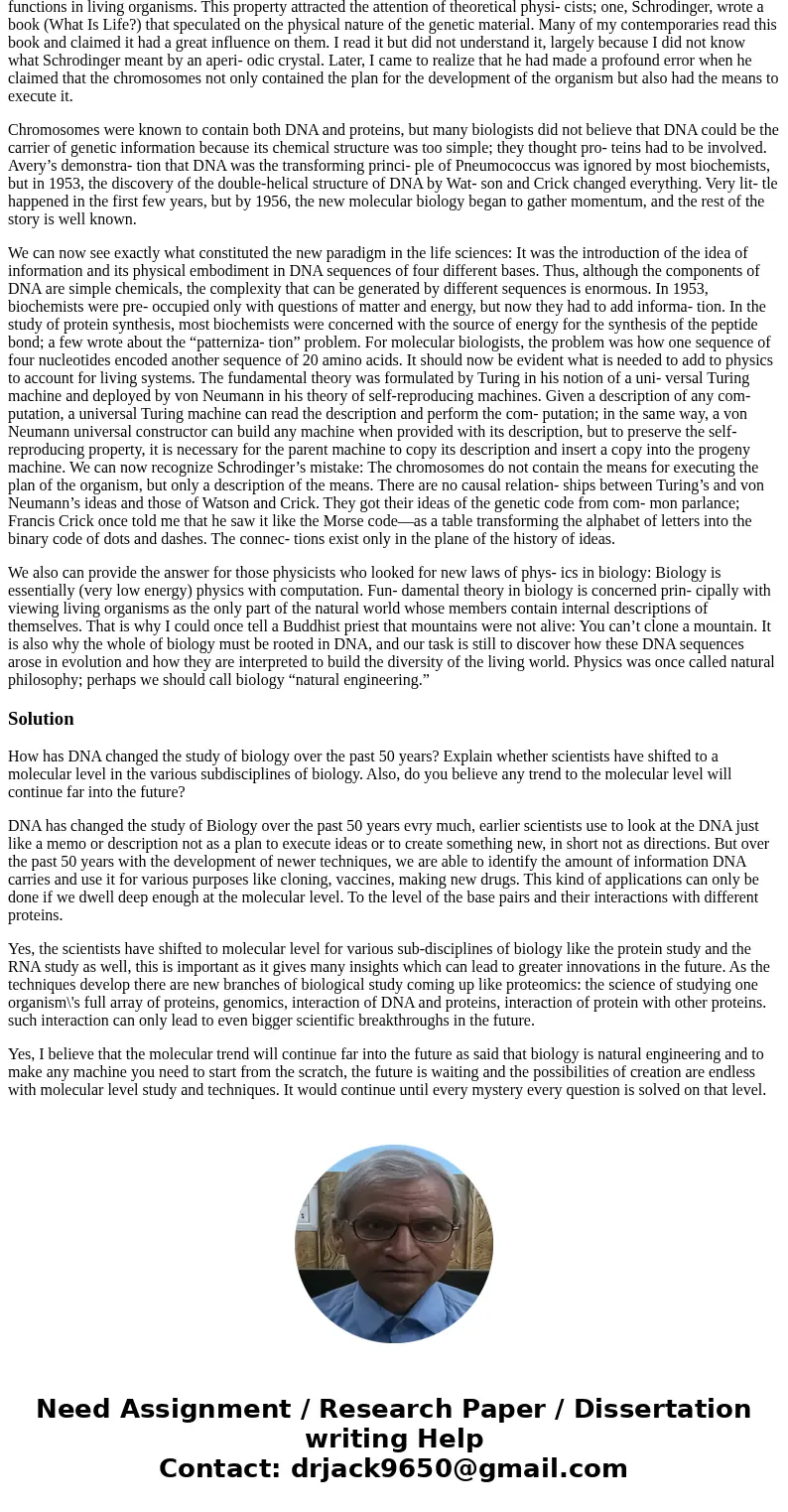Answer the following questions from the Article below Exerci
Answer the following questions from the Article below:
Exercise #1. Read the following article and then answer the following questions in paragraph form.
1. How has DNA changed the study of biology over the past 50 years? Explain whether scientists have shifted to a molecular level in the various subdisciplines of biology. Also, do you believe any trend to the molecular level will continue far into the future?
2. Explain the role of DNA in the development of an organisms. Does DNA fully provide a blueprint to create an individual? Can DNA by itself propagate itself or does it require other molecular machines?
3. In modern biology, which is the role of physics in the study of organisms and their molecules? Has physics moved to the forefront or does it play an ancillary role? As described in the article, why are the molecular forces of very low energy in an organism?
Historians have the luxury of look- ing back at human endeavor over long periods of time, but most scien- tists are too busy working in the present and thinking anxiously about the future and have no time to view their work in the context of what has gone before. I once remarked that all graduate students in biology divide history into two epochs: the past 2 years and every- thing else before that, where Archimedes, Newton, Darwin, Mendel—even Watson and Crick—inhabit a time-compressed universe as uneasy contemporaries. It seems remark- able that historians once thought that science progressed by the steady addition of knowl- edge, building the edifice of scientific truth, brick by brick. In his 1962 book The Struc- ture of Scientific Revolutions, Thomas Kuhn argued that progress occurs in revolutionary steps by the introduction of new paradigms, which may be new theories—new ways of looking at the world—or new technical meth- ods that enhance observation and analysis.
Between Kuhn’s revolutions, scientif ic knowledge does advance by accretion, as there is much to do to consolidate the new sci- ence. But then, inevitably, unsolved problems accumulate and, in many cases, the inconsis- tencies have been put to one side and every- body hopes that they will quietly go away. The edifice becomes rickety; some of its founda- tions are insecure and many of the bricks have not been well-baked. This is when a new rev- olutionary wave in the form of new ideas or new techniques appears, which allows us to condemn and demolish the unsafe or corrupt parts of the edifice and rebuild truth. Often there is great resistance to the new wave, but as Max Planck pointed out, it succeeds because the opponents grow old and die. The process is then repeated: The radicals become liberals, the liberals become conservatives, the conservatives become reactionaries, and the reactionaries disappear. Students of evolu- tion will recognize this process in the theory of punctuated equilibrium: Organisms stay much the same for very long periods of time; this is interrupted by bursts of change when novelty appears, followed again by stasis.
The life sciences have undergone a radical revolution in my lifetime, and it is interesting to view this from the vantage point of the pres- ent to understand its full meaning and impact. In the first half of the 20th century, physics underwent two revolutions: Einstein’s theory of relativity, connected with large scales of time and space, and quantum mechanics, con- cerned with the very small and dealing with fundamental questions of matter and energy. Although Newton still reigned supreme in the human-scale world, the revolutions opened up totally new fields of the physical sciences whose impact continues today. In the mean- time, genetics had shown that chromosomes were the carriers of genes that specified the phenotypic characteristics of organisms and were the modern version of the factors postu- lated by Mendel—but beyond that, very little was known about the material basis of genes and how they accomplished their proposed functions in living organisms. This property attracted the attention of theoretical physi- cists; one, Schrodinger, wrote a book (What Is Life?) that speculated on the physical nature of the genetic material. Many of my contemporaries read this book and claimed it had a great influence on them. I read it but did not understand it, largely because I did not know what Schrodinger meant by an aperi- odic crystal. Later, I came to realize that he had made a profound error when he claimed that the chromosomes not only contained the plan for the development of the organism but also had the means to execute it.
Chromosomes were known to contain both DNA and proteins, but many biologists did not believe that DNA could be the carrier of genetic information because its chemical structure was too simple; they thought pro- teins had to be involved. Avery’s demonstra- tion that DNA was the transforming princi- ple of Pneumococcus was ignored by most biochemists, but in 1953, the discovery of the double-helical structure of DNA by Wat- son and Crick changed everything. Very lit- tle happened in the first few years, but by 1956, the new molecular biology began to gather momentum, and the rest of the story is well known.
We can now see exactly what constituted the new paradigm in the life sciences: It was the introduction of the idea of information and its physical embodiment in DNA sequences of four different bases. Thus, although the components of DNA are simple chemicals, the complexity that can be generated by different sequences is enormous. In 1953, biochemists were pre- occupied only with questions of matter and energy, but now they had to add informa- tion. In the study of protein synthesis, most biochemists were concerned with the source of energy for the synthesis of the peptide bond; a few wrote about the “patterniza- tion” problem. For molecular biologists, the problem was how one sequence of four nucleotides encoded another sequence of 20 amino acids. It should now be evident what is needed to add to physics to account for living systems. The fundamental theory was formulated by Turing in his notion of a uni- versal Turing machine and deployed by von Neumann in his theory of self-reproducing machines. Given a description of any com- putation, a universal Turing machine can read the description and perform the com- putation; in the same way, a von Neumann universal constructor can build any machine when provided with its description, but to preserve the self-reproducing property, it is necessary for the parent machine to copy its description and insert a copy into the progeny machine. We can now recognize Schrodinger’s mistake: The chromosomes do not contain the means for executing the plan of the organism, but only a description of the means. There are no causal relation- ships between Turing’s and von Neumann’s ideas and those of Watson and Crick. They got their ideas of the genetic code from com- mon parlance; Francis Crick once told me that he saw it like the Morse code—as a table transforming the alphabet of letters into the binary code of dots and dashes. The connec- tions exist only in the plane of the history of ideas.
We also can provide the answer for those physicists who looked for new laws of phys- ics in biology: Biology is essentially (very low energy) physics with computation. Fun- damental theory in biology is concerned prin- cipally with viewing living organisms as the only part of the natural world whose members contain internal descriptions of themselves. That is why I could once tell a Buddhist priest that mountains were not alive: You can’t clone a mountain. It is also why the whole of biology must be rooted in DNA, and our task is still to discover how these DNA sequences arose in evolution and how they are interpreted to build the diversity of the living world. Physics was once called natural philosophy; perhaps we should call biology “natural engineering.”
Solution
How has DNA changed the study of biology over the past 50 years? Explain whether scientists have shifted to a molecular level in the various subdisciplines of biology. Also, do you believe any trend to the molecular level will continue far into the future?
DNA has changed the study of Biology over the past 50 years evry much, earlier scientists use to look at the DNA just like a memo or description not as a plan to execute ideas or to create something new, in short not as directions. But over the past 50 years with the development of newer techniques, we are able to identify the amount of information DNA carries and use it for various purposes like cloning, vaccines, making new drugs. This kind of applications can only be done if we dwell deep enough at the molecular level. To the level of the base pairs and their interactions with different proteins.
Yes, the scientists have shifted to molecular level for various sub-disciplines of biology like the protein study and the RNA study as well, this is important as it gives many insights which can lead to greater innovations in the future. As the techniques develop there are new branches of biological study coming up like proteomics: the science of studying one organism\'s full array of proteins, genomics, interaction of DNA and proteins, interaction of protein with other proteins. such interaction can only lead to even bigger scientific breakthroughs in the future.
Yes, I believe that the molecular trend will continue far into the future as said that biology is natural engineering and to make any machine you need to start from the scratch, the future is waiting and the possibilities of creation are endless with molecular level study and techniques. It would continue until every mystery every question is solved on that level.


 Homework Sourse
Homework Sourse